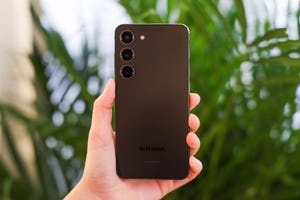
Samsung Galaxy S23 Specs vs. Google Pixel 7: Android Phones Compared - CNET
This story is part of Samsung Event, CNET’s collection of news, tips and advice around Samsung’s most popular products.
Samsung launched its first flagship smartphones in 2023, introducing the Galaxy 23 line. The South Korean company held its Samsung Unpacked event in San Francisco to announce its mobile wares which compete with Google’s Pixel 7 and Apple’s iPhone 14 series.
Perhaps the most obvious difference right off the bat is the price. The Samsung Galaxy S23 lineup starts at $800 (roughly £645, AU$1,120) while the Pixel 7 starts at $599 (£599, AU$999), the same price held by 2021’s Pixel 6. Unfortunately for Google, however, this price difference may not actually matter in the US, where most people buy devices from wireless carriers that offer enticing upgrade deals on new Galaxy phones and iPhones.
Apart from the price, the Galaxy 23 and Pixel 7 differ in design, chipset, battery and display size. For instance, Google has a so-called camera bar running across the width of the chassis and uses its home-made chipset, known as the Tensor 2, while the Galaxy S23 runs on a special version of the Snapdragon 8 Gen 2 and lacks a camera bar or camera bump. Scroll down below for a side-by-side look at the differences in specs.
The camera is a key deciding factor when buying a flagship phone. It’s worth noting that Samsung’s $800 Galaxy S23 has a dedicated telephoto camera for capturing faraway objects, which isn’t available on the more affordable Pixel 7. You have to move up to the $899 Pixel 7 Pro for that sweet optical telephoto zoom.
Last year’s Galaxy S22 was already one of the best night-time camera phones, beating out the Pixel 7 Pro in our tests. It’ll be interesting to see how much further the upgraded Galaxy S23 will take it. The Galaxy S23 Ultra, the most-expensive of Samsung’s new Galaxy S line, has a 200-megapixel main camera, which should take the image quality capabilities to the next level.
For more information on how Samsung’s Galaxy S23 series compares with Google’s Pixel 7 series, take a look at below.
Samsung Galaxy S23 series specs vs. Google Pixel 7 series
| Galaxy S23 | Google Pixel 7 | Galaxy S23 Plus | Google Pixel 7 Pro | Galaxy S23 Ultra | |
|---|---|---|---|---|---|
| Display size, resolution, brightness | 6.1-inch AMOLED; 2,340×1,080 pixels; 120Hz Adaptive Refresh Rate; 1,750 nits | 6.3-inch OLED display, FHD+ (1,080 x 2,400 pixels) , 90Hz | 6.6-inch AMOLED; 2,340×1,080 pixels; 120Hz Adaptive Refresh Rate; 1,750 nits | 6.7-inch LTPO display, 120Hz QHD+ (1,440 x 3,120 pixels) | 6.8-inch AMOLED 3,088×1,440 pixels; 120Hz Adaptive Refresh Rate; Edge Screen; 1,750 nits |
| Pixel density | 425 ppi | 416 ppi | 393 pppi | 512ppi | 500 ppi |
| Dimensions (Inches) | 2.79 x 5.76 x 0.3 in | 6.13 x 2.88 x 0.34 in | 3 x 6.21 x 0.3 in | 6.14 x 3.02 x 0.35 in | 3.07 x 6.43 x 0.35 in |
| Dimensions (Millimeters) | 70.9 x 146.3 x 7.6 mm | 155.6 x 73.2 x 8.7 mm | 76.2 x 157.7 x 7.6 mm | 162.9 x 76.6 x 8.9 mm | 78 x 163.3 x 8.9 mm |
| Weight (Ounces, Grams) | 168 g (5.93 oz) | 197g (6.9 oz) | 196 g (6.91 oz) | 212 g (7.5 oz) | 234 g (8.25 oz) |
| Mobile software | Android 13 | Android 13 | Android 13 | Android 13 | Android 13 |
| Camera | 50-megapixel (wide), 12-megapixel (ultrawide), 10-megapixel (telephoto) | 50-megapixel (main), 12-megapixel (ultra-wide), | 50-megapixel (wide), 12-megapixel (ultrawide), 10-megapixel (telephoto) | 50-megapixel (main), 12-megapixel (ultra-wide), 48-megapixel (telephoto) | 200-megapixel (wide), 12-megapixel (ultrawide) 10-megapixel (telephoto) 10-megapixel (telephoto) |
| Front-facing camera | 12-megapixel | 10.8- megapixel | 12-megapixel | 10.8- megapixel | 12-megapixel |
| Video capture | 8K at 30 fps | 4K | 8K at 30 fps | 4K | 8K at 30 fps |
| Processor | Galaxy-optimized Qualcomm Snapdragon 8 Gen 2 | Google Tensor G2 | Galaxy-optimized Qualcomm Snapdragon 8 Gen 2 | Google Tensor G2 | Galaxy-optimized Qualcomm Snapdragon 8 Gen 2 |
| RAM/Storage | 8GB RAM + 128GB; 8GB RAM + 256GB | 8GB + 128 GB, 8GB + 256 GB, | 8GB + 256GB; 8GB + 512GB | 12GB + 128 GB, 12GB + 256GB, 12GB + 512GB | 12GB + 256GB; 12GB + 512GB; 12GB + 1TB |
| Expandable storage | None | None | None | None | None |
| Battery/Charging speeds | 3,900 mAh (25W wired charging) | 4,355 mAh (20W wired charging) | 4,700 mAh (45W wired charging) | 5,000 mAh (20W wired charging) | 5,000 mAH (45W wired charging) |
| Fingerprint sensor | In-display | In-display | In-display | In-display | In-display |
| Connector | USB-C | USB-C | USB-C | USB-C | USB-C |
| Headphone jack | None | None | None | None | None |
| Special features | 5G (mmw/Sub6), IP68 rating, faster wired charging, wireless PowerShare to charge other devices | 5G, IP68 rating, Face Unblur | 5G (mmw/Sub6), IP68 rating, faster wired charging, wireless PowerShare to charge other devices, UWB for finding other devices | 5G, IP68 rating, Face Unblur | 5G (mmw/Sub6), IP68 rating, faster wired charging, wireless PowerShare to charge other devices, integrated S-Pen, 200x Space Zoom, 10x Optical Zoom, UWB for finding other devices |
| Price off-contract | $800 (8GB/128GB) | $599 | $1,000 (8GB/256GB) | $899 (£849, AU$1,299) | $1,200 (12GB/256GB) |
| Price (GBP) | Converts to £769 (8GB/128GB) | £599 | Converts to £645 | £849 | Converts to £970 |
| Price (AUD) | AU$1,249 (8GB/128GB) | AU$999 | Converts to AU$1,120 | AU$1,299 | Converts to AU$1,680 |


